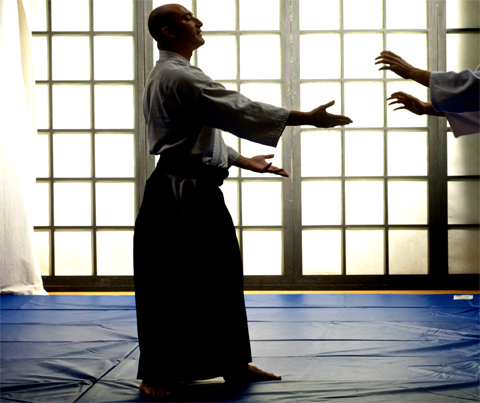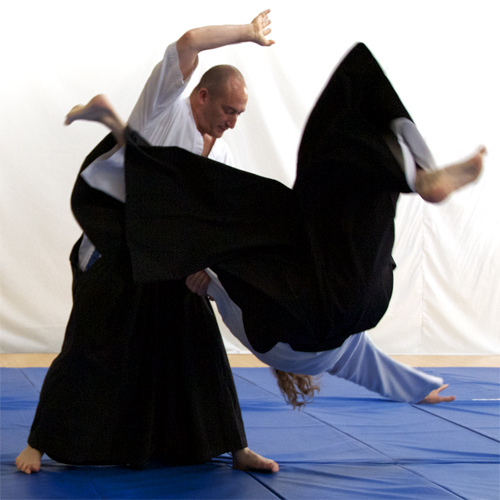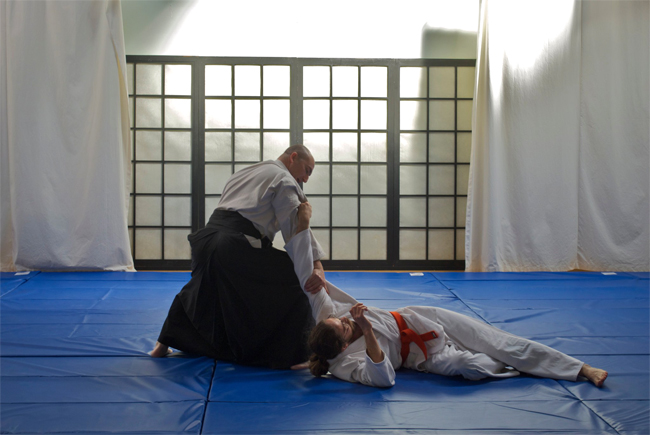 This interview with Nick Walker Sensei was conducted by Monika Broecker, founder of the Center for Personal Growth, in February 2011.
This interview with Nick Walker Sensei was conducted by Monika Broecker, founder of the Center for Personal Growth, in February 2011.
MB: What is your vision for your Aikido dojo?
NW: Aikido has enormous potential as a transformative practice of mindfulness, open-hearted presence, and compassionate power. I’m always working to create a training environment where that potential can be fully explored and realized. A cooperative learning environment that’s supportive, inclusive, and accepting.
For a group practice setting like a martial arts dojo or a yoga studio to truly support deep personal growth and transformation, there has to be permission for people to be at whatever point in their work they’re at, working on whatever their edge is at that moment. Permission to have difficulty learning something, to try and experiment and never be perfect, to always be a work in progress. There has to be space for people to feel what they’re feeling: space for tears or laughter; space to let out a roar or a deep sigh; space to say, “Wow, that was so intense I need to just sit down and breathe for a few minutes.” All of this needs to be allowed, accepted, embraced. As a teacher, that’s the sort of environment I try to cultivate.
To me, the truest measure of an Aikido dojo’s success is this: Is the world a better place because this dojo is in it? A successful Aikido student is one who finds some joy, mindfulness, and loving strength in her practice, and brings it with her into her life, her community, all of her interactions, in a way that spreads ripples of goodwill out into the world.
MB: How has your Aikido practice affected your life?
NW: I consider the Aikido dojo to be a laboratory in which you refine your ability to embody your spiritual principles in the rest of your life. I’ve always used it to explore and develop whatever I needed to bring into my life. I grew up in poverty, in an environment where sudden incidents of violence were a daily fact of life. Aikido helped me to develop the embodied confidence, calmness, stability, and resourcefulness to survive in that environment without getting sucked into the cycles of rage and mayhem around me. As I transitioned into adulthood, it became more about presence, fluidity, and balance: exploring the embodiment of masculine and feminine power, assertiveness and receptivity, yin and yang, grounded stillness and fluid motion. And in recent years, as I’ve entered early middle age, fatherhood, and a quieter life of teaching and scholarship, Aikido has become more of a path of healing for me, a practice of opening to compassion.
MB: How does Aikido help people to become grounded and centered?
NW: Aikido is an interactive art, an art meant to be practiced in a group setting, in collaboration, in community, in sangha. If the basic building block of yoga is the asana, or “pose,” the basic building block of Aikido is the waza, or “technique.” An Aikido technique is a movement that’s intended as a grounded and harmonious response to aggression: if someone tries to grab you this way, move this way to free yourself from the grab and take his balance. The greater part of any Aikido class is spent in partner training: the teacher demonstrates a technique and the students pair off and practice it in partners, taking turns playing the role of the “aggressor” who performs some specific intrusive act – a push, a grab – so that the other partner can practice performing the technique in response.
Because of its constantly interactive nature, Aikido trains people to be grounded and graceful under pressure. I’ve met a lot of people who’ve had the experience of going off to a retreat in some idyllic environment where everything happens very slowly, everyone is quiet and respectful and nice, and they meditate and do yoga and sit in hot springs all day. They feel so relaxed and peaceful! And then they come back to their everyday lives, to the everyday challenges of family, relationships, work, deadlines, crowded stores and streets and sidewalks, and suddenly their bliss is gone and they’re stressed out and they can’t wait for the next retreat. Their inner peace only lasted as long as their external situation was idyllic and peaceful and soothing.
With Aikido, we take the opposite approach: we practice being grounded and peaceful and relaxed while someone is right in our face, grabbing our arm, pushing on our shoulder. Practicing to respond gracefully to that, to be grounded, peaceful and relaxed under those conditions, centers you in a whole different way – a way that’s sustainable in the bustle of everyday modern living, in the ever-shifting and sometimes chaotic world of human interaction and relationship. Then, instead of your inner peace being dependent on your surroundings staying peaceful, you carry peace with you and help to spread that peace outward to your surroundings, wherever you go.
Aikido comes from an Eastern tradition that doesn’t have the dualistic model of mind and body that one finds in mainstream Western thought. So we don’t see “relaxation” and “grounding” as abstracts, as intangible mental states. If your mind is truly relaxed, your body is relaxed; if you can truly relax your body, your mind will relax. If you’re truly centered and grounded, then when someone pushes on your shoulder, you keep your balance better. So our physical interactions with our partners in Aikido class provide immediate feedback that helps us to make honest assessments of our centeredness, and to really hone in on the qualities we’re trying to cultivate.
 MB: What are some other benefits of Aikido practice?
MB: What are some other benefits of Aikido practice?
NW: Well, it’s great exercise. One’s entire body is in continual motion, and the range of motions is very broad. It’s great for developing coordination, balance, poise, flexibility, core strength, and body awareness. Great aerobic conditioning, too.
Aikido builds what I’d call “relaxed strength,” or “fluid power.” In the conventional Western conception of physical strength, power is often equated with muscle tension, with flexing and straining. But this sort of strength is difficult to sustain and hard on the body, and tightly tense muscles are vulnerable to injury and don’t feel especially good. Fluid power comes from using the whole body in coordination, in a state of relaxation that allows a movement to travel through the body like a wave. You can see this same phenomenon in tai chi and kung fu masters, in great athletes and dancers, and in cats.
I think one of the most powerful and unusual benefits of Aikido is the way it transforms one’s responses to stress, aggression, and conflict on a neuoromuscular level. The main reason conflicts go badly is that when human beings feel sufficiently threatened, the sympathetic nervous system goes on red alert and the primal “fight, flight or freeze” response kicks in. Fight-flight-freeze responses have definite survival value in extreme situations, but in the modern world, they can be extremely problematic. People can get “triggered” into fight-flight-freeze responses in situations where they’re not actually in immediate physical danger, and end up escalating their problems further, because those primal responses tend to override higher brain functions like reason, empathy, creativity, and compassion. Or, in a situation of actual physical danger, a person might freeze up – or run or fight in a blind panic – and miss an opportunity for escape or other effective strategic action.
In Aikido training, we constantly practice responding to direct physical threats – being grabbed, having someone try to hit us – by instantly grounding, relaxing, and going into fluid, effective action and heightened awareness. We practice this over and over and over, every class, sometimes fast, sometimes very slowly. What we’re doing is retraining the reflexes, retraining the body, retraining the brain. We’re reprogramming ourselves at a neuromuscular level, overwriting our old fight-flight-freeze responses with a new set of responses: grounding, relaxing, spontaneous fluidity of movement. The more one works at this, the more one becomes able to regulate one’s physical and emotional responses in the midst of stressful situations of any kind – to stay conscious and clear-headed; to quickly ground, center, and relax at will.
MB: Is Aikido for everyone?
NW: Yes and no. Everything I’ve witnessed and heard in my years of teaching has led me to believe that anyone can learn Aikido, if they persist in their practice. And absolutely everyone who does persist in long-term practice ends up deriving great benefit from it on many levels.
On the other hand, the capacity for that kind of persistence is a rare quality in today’s culture of instant gratification. Most people start out enthusiastic and then disappear whenever they hit the first major challenge in their practice. A lot of people don’t even make it past their first class, or their first couple of weeks.
MB: What’s the greatest challenge faced by beginning Aikido students, and is there a secret to mastering that challenge?
NW: I’d say the greatest challenge most people face in the early stages of Aikido training is the Inner Critic. Aikido is not an easy art to learn. It’s a whole new vocabulary of movement, like trying to learn a new language of the body. In the early stages of one’s training, one spends a great deal of time being confused, fumbling one’s way through these new movements that can feel quite awkward and counterintuitive at first. And people with fragile egos and oppressive Inner Critics often can’t tolerate feeling confused and awkward for very long. Their Inner Critics torment them with thoughts like, “I should be better at this,” or, “I guess I’m just not fit or coordinated enough to do this.” Which is nonsense. Every single person who’s ever gotten really good at Aikido spent a lot of time being really bad at it first. Some people come in the door with more athletic ability than others, and that sort of ability can make a difference in the early years of one’s practice, but in the long run, simple, humble persistence is the key, the one and only secret to mastery.
Aikido is a long-term path of transformation and growth, like zen meditation or yoga: a path that gradually opens you to deeper and deeper levels of grace and embodied wisdom over the course of years and decades. Success and mastery come to those students who defy their Inner Critics and let go of impatience and perfectionism – the students who keep showing up to practice and just enjoy learning and playing and moving, without allowing the Inner Critic to impose a lot of “shoulds” on the process.
Creative people often do well in Aikido because Aikido and creativity both require a willingness to feel one’s way through unfamiliar territory, a tolerance for ambiguity, and an ability to thumb one’s nose at the Inner Critic. For that same reason, sometimes people who never thought of themselves as particularly creative experience an awakening of their creative sides as a result of their Aikido practice.
MB: What’s the best way to begin Aikido training?
NW: Just show up at an Aikido class. Show up for class early; wear clothing you can move in. Get on the mat and start practicing. That’s the only way to do it. One of the best things about the standard Aikido class format – pairing off and practicing techniques with a partner – is that beginners are always well-taken-care-of, at least in my dojo. When you’re a beginner, the advanced students seek you out and partner with you, and work with you gently at whatever pace is right for you. You get one-on-one personal instruction on every technique.
There’s a wonderful attitude of “pay it forward” in a good Aikido dojo. Everyone on the mat was once an awkward beginner who knew nothing about the art. They were able to learn because more experienced students practiced with them and helped them as much as they needed. So they love beginners because it’s a chance to “pay it forward,” to take their turn supporting new Aikido students as they themselves were supported. So as a beginner to Aikido, you just show up and dive in, and in a good dojo, the support will be there for you. Any day is a good day to start.
